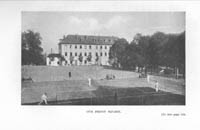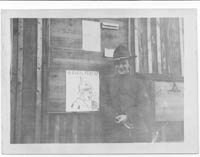Table of Contents
Media Index
CHAPTER 14
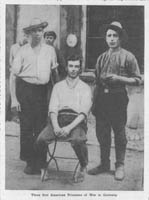
These three American prisoners were among the first incarcerated by the Germans after the United States declared war on Germany in April 1917. One of the Americans is barefoot and their clothing is in bad shape. They may have been U-boat victims which would explain their desperate situation. Their lives would improve with the arrival of their American Red Cross parcels.
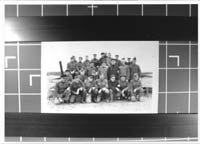
Group photograph of the first 21 American prisoners of war in Germany, taken by a WPA secretary during a camp visit.
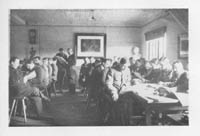
Entente prisoners read books, journals, and newspapers in the reading room at the prison camp at Giessen. The room is well attended and features a clock, several paintings, and two statues. All of the seats at the table are taken by prisoners who pass they idle hours by reading.
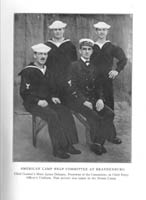
These four American sailors constituted the American Camp Help Committee at the prison camp at Brandenburg. This committee was responsible for the care of American prisoners in the facility and made sure that arriving prisoners received emergency funds and American Red Cross packets. Many prisoners, victims of torpedo attacks, detrained at Brandenburg without any personal belongings (the Germans assigned sailors and merchant mariners to this facility).
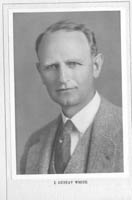
Portrait of J. Gustav White (1881-1979), an American YMCA WPA Secretary in Germany from 1916 to 1917, he transferred to the World's Committee in Geneva and became the Education Secretary for the World's Alliance of YMCA's.
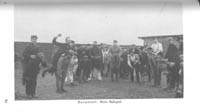
French prisoners play an interesting ball game on the backs of their comrades in the prison compound at Darmstadt. It is interesting to note that several of the "horses" are smoking pipes while their "jockeys" prepare to play.
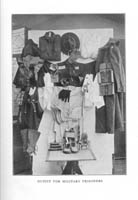
The American Red Cross assumed that captured U.S. prisoners required a new uniform after fighting in the trenches and subsequent capture. As a result, the Red Cross sent each American POW a new uniform, overcoat, hat, underwear, socks, gloves, scissors, thread, shoes, shoe polish, shoe brush, and travel bag.
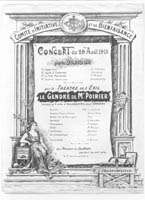
The Commite d'Initiative et de Bienfaisance at Friedrichsfeld sponsored this four-part comedy play, "Le Gendre de M. Poirer," on 29 August 1915. The play was performed by the Theatre de I'Exil to help entertain the prisoners in the camp. The lithographed program was produced by prisoners in the camp.
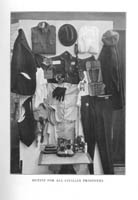
The American Red Cross also sent a complete set of new clothes to American civilian internees imprisoned in German prison camps. Civilians received the same clothing for American military prisoners of war, except for the U.S. Army uniform. Instead, they received civilian clothing which included a jacket, vest, trousers, tie, hat, and cap. This clothing kit was especially welcomed by merchant mariners who lost most of their clothing when they ships were torpedoed.
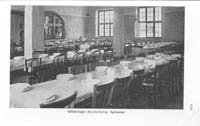
This was the dining hall officers used in the prison camp at Heidelberg. Each of the tables is covered with a white table cloth and each place is set with a bowl, plate, and cup. Note the bottles of wine on the back table and on the sill of the rear window.
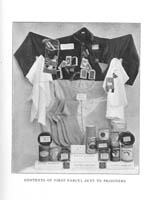
When an American soldier arrived at a German prison camp, the American Red Cross sent the POW this parcel. It included a wide range of items that would prove very useful in captivity and the Red Cross assumed that the prisoner lost all of his kit when he was captured. The first parcel included a shirt, soci, underwear, towels, shaving kit, brush, tooth brush, cigarettes, safety pins, sewing kit, soap, hard bread, coffee, sugar, and cans of corned beef, condensed milk, salmon, corn, tomatoes, beans, and pork and beans.
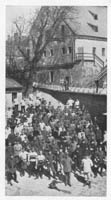
A number of incarcerated prisoners (primarily Russian officers with a few French POW's) stand in the courtyard of the fortress waiting for their dinner. There are a number of German guards on the left hand side as well as German staff members to the rear of the group.
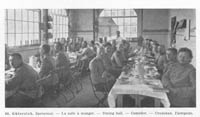
Russian officers enjoy a meal in the dining hall in the prison camp at Guetersloh. They drink coffee and beer with their dinners.
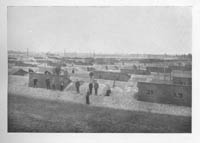
Russian prisoners stand in front of earthen barracks in the prison camp at Hammerstein. Winter weather in eastern Germany was severe and the Germans constructed barracks in the ground in an atempt to keep the quarters warmer.
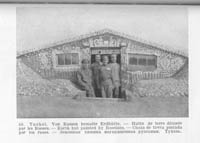
Four Russians stand in the doorway of their earthen barrack at Tuchel I. They have decorated the front of the barrack by painting designs around the door and windows. These types of earthen huts were considered unsanitary and unhealthy by neutral inspectors because of the lack of ventilation which contributed to the spread of design. On the other hand, these barracks were insulated by earth and were warm in the winter.
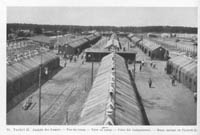
View of the prison camp at Tuchel II, probably from the prison water tower or a guard tower. This photograph shows a number of new wooden barracks that have gadrens in front of the doors. Note the number of smoke stacks in the roofs of the barracks which reflect a concern for heat and ventilation. To the left, a large new building is under construction with prisoners providing the labor.
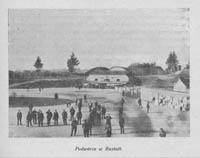
Interned civilians and POW's mill about the court yard at Rastatt, while some prisoners compete in a bowling game in the background.
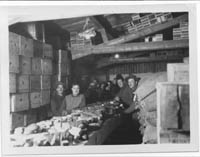
The members of the American Distribution Committee divide up and organize ten days' supply of food for American prisoners of war at Rastatt, after the parcels passed through German inspection. The American Red Cross sent the food to Germany to ensure the good health of American prisoners.
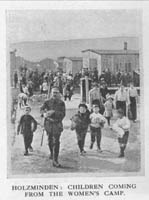
A group of children leave the women's compound of the prison camp at Holzminden accompanied by a Landsturm guard. They pass by a sentry's guard box, which marks the entrance to the women's section of the camp and may be enroute to school or some other activity.
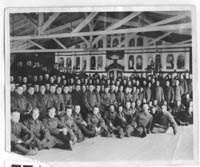
American prisoners of war crowd a religious service in the prison camp at Rastatt. This was a Russian Orthodox Church used by the Ukrainian POW's, but the Americans had access to the building for their divine services.
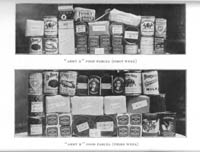
The American Red Cross sent U.S. prisoners of war in German prison camps a different food parcel every week. The "A" food parcel, which POW's received in the first week of their captivity, included a can opener, dried fruit, biscuits, cigarettes, soap, salt pork, and cans of tomatoes, corn, peas, corned beef hash, corned beef, beans, butter, pork and beans, and salmon. They received "B" food parcels, bottom photograph, during the third week in captivity, which included biscuits, dried fruit, coffee, sugar, tobacco, rice, and cans of pork and beans, corned beef hash, tomoatoes, corn, roast beef, corned beef, sweat peas, condensed milk, string beans, and salmon. American prisoners lived like kings in German prison camps, given the effect on the German population of the Allied blockade.
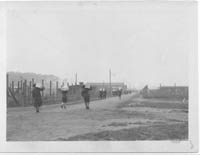
American POW's with fresh American Red Cross food parcels on their shoulders walk back to their barracks in the prison camp at Rastatt.
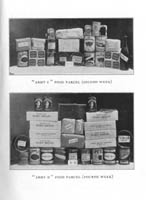
During the second week in captivity, the American Red Cross sent U.S. POW's in German prison camps "C" food parcels, top picture, which included cocoa, biscuits, cigarettes, salt pork, dried fruit, sugar, vinegar, and cans of tomatoes, beans, corned beef hash, roast beef, corned beef, corn, sweet peas, and pork and beans. The American Red Cross sent "D" food parcels during the fourth week of a prisoner's captivity. These packages held tobacco, hard bread, sugar, salt, coffee, chocolate, and cans of roast beef, jam, tomatoes, sweet peas, corn, corned beef hash, evaporated milk, and salmon. American POW's received far better fare than their German guards.
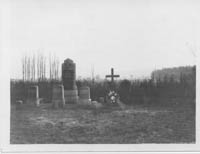
A new grave for an American POW, highlighted by the wreath on the cross, stands near the YMCA memorial in the cemetery at Rastatt.
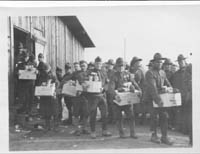
American prisoners of war line up outside the Parcel Post Office at Rastatt with ten days' supply of food in the boxes on their shoulders. This food was sent to the prison camp by the American Red Cross to make sure that American soldiers survived their captivity in Germany. The generous amount of food received by American POW's during the famine conditions in Germany caused by the Allied naval blockade caused a great deal of consternation among German authorities, especially when guards caught American POW's "playing with their food." As one prisoner pointed out, canned food would not spoil even if the prisoners had a little fun playing games.
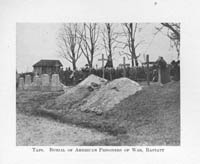
An American buglar plays taps in the POW cemetery in Rastatt for two dead comrades. The American YMCA band, to the rear at the left, was part of the funeral entourage. Note the German civilians, including a child, in attendance to the right.
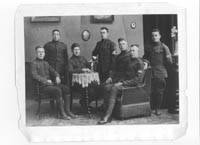
Seven members of the YMCA Committee at Rastatt pose for a photograph in a comfortable sitting room. They served as the officers of the Rastatt Association, to implement the YMCA program with the aid of an Association secretary who made periodic visits to the camp to restore supplies and equipment and to address any problems with operations. The WPA Secretary helped organize Associations within each camp, recruiting POW's with YMCA experience or special talents to implement the program. Note the POW identification number on the upper arm of the prisoners.
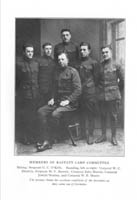
Six members of the American Help Committee at Rastatt pose for a photograph at the time of their release. Note the excellent condition of these men despite their incarceration in a German prison camps.
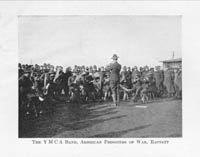
The YMCA Band performs an outdoor concert for the general prison population at Rastatt. The American YMCA provided all of the instruments for the band.
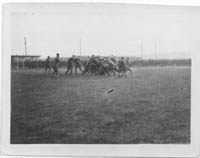
American POWs continued to play baseball, football, and volleyball in German prison camps with sports equipment supplied by the YMCA. U.S. soldiers are in the middle of a football game on the compound at Rastatt with a sizeable crowd of spectators cheering them on.
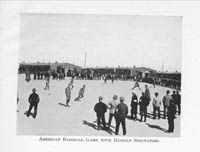
The ball is on its way to the plate as American prisoners of war play a game of baseball in the compound of Rastatt, for the entertainment of Ukrainian spectators.
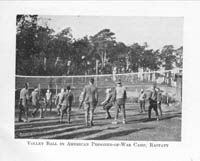
The ball is in play high above the net as American POW's enjoy a game of volleyball in the compound at Rastatt. The American YMCA "invented" basketball and volleyball to make better use of their gymnasiums.
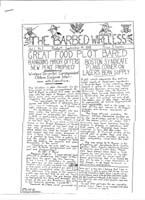
This is the front page of the first edition of "The Barbed Wireless," a newspaper for American POW's at Rastatt, a German propaganda camp for Ukrainian prisoners of war (note that the price of the newspaper is in kopeks, the prison camp's currency). The newspaper focused on humor, as reflected on the two headline stories, and cartoons (the newspaper was mimeographed). The editors included sports scores and camp announcements, featuring YMCA activities.
